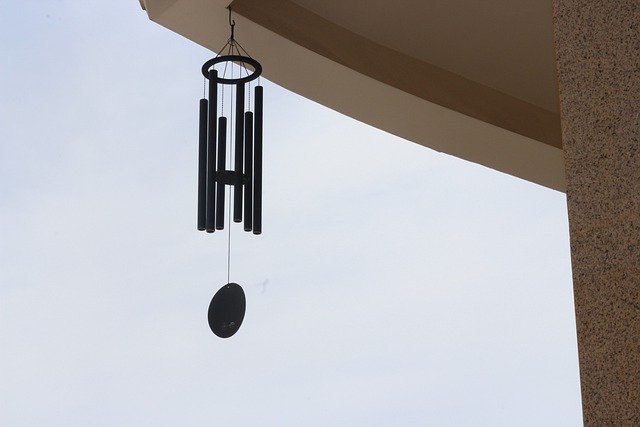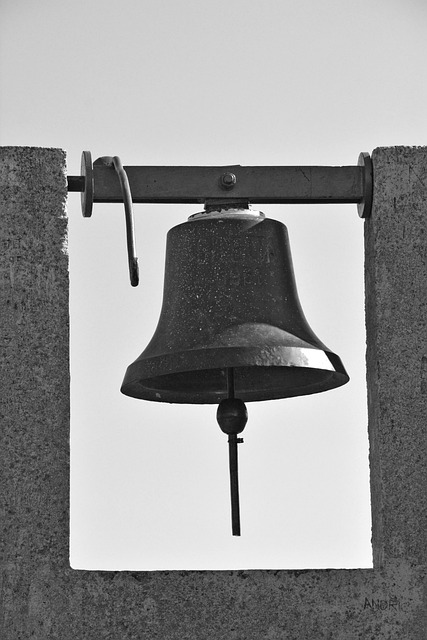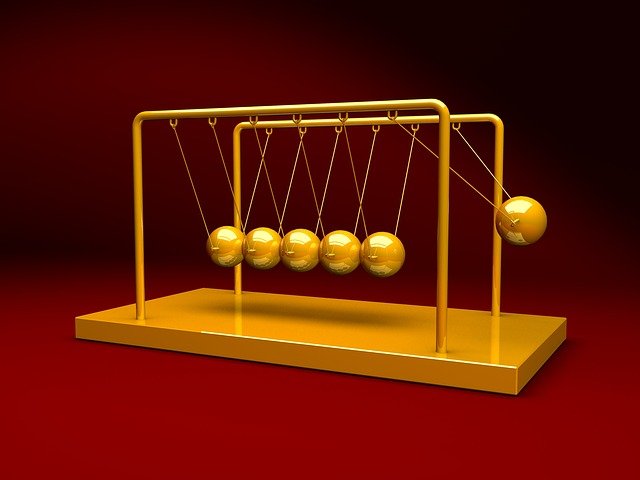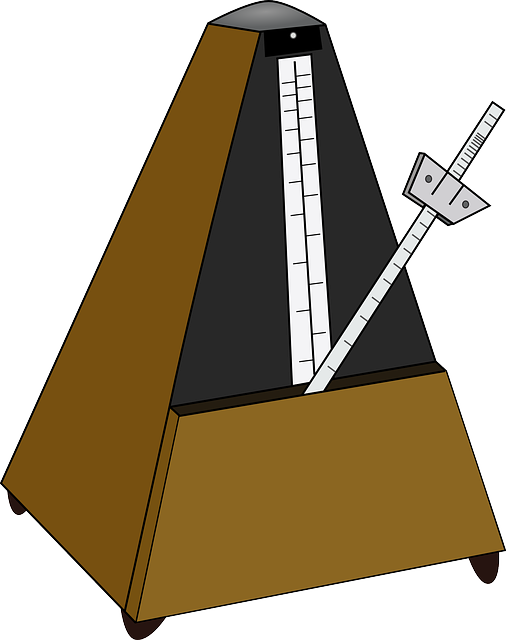Introduction:
A pendulum is a simple yet fascinating device that consists of a weight suspended from a fixed point, allowing it to swing back and forth. It is a classic example of harmonic motion and can be found in various forms in our daily lives. From grandfather clocks to amusement park rides, pendulums are used in a wide range of applications. In this article, we will explore some interesting examples of pendulums and their practical uses.
Key Takeaways:
| Example | Description |
|---|---|
| Grandfather Clock | A pendulum is used to regulate the movement of the clock’s hands. |
| Swinging Bridge | Pendulums are used to reduce the sway of the bridge caused by wind or vibrations. |
| Foucault Pendulum | Demonstrates the rotation of the Earth by swinging in a fixed plane. |
| Metronome | A pendulum is used to keep time in music. |
| Newton’s Cradle | A series of pendulums used to demonstrate conservation of momentum. |
Types of Pendulums
Pendulums are fascinating objects that exhibit a unique type of motion known as pendulum motion. There are various types of pendulums, each with its own characteristics and applications. Let’s explore some of the most common types of pendulums:
Simple Pendulum
The simple pendulum is the most basic type of pendulum. It consists of a mass, called the bob, attached to a string or rod of fixed length. When the bob is displaced from its equilibrium position and released, it swings back and forth in a regular pattern. The motion of a simple pendulum is a classic example of a harmonic oscillator, where the bob oscillates with a constant period. Simple pendulums are often used in physics experiments to study concepts such as potential energy, kinetic energy, and damping.
Foucault’s Pendulum

Foucault’s pendulum is a mesmerizing pendulum that demonstrates the rotation of the Earth. It consists of a long, heavy bob suspended from a high ceiling. As the pendulum swings back and forth, its plane of oscillation appears to rotate slowly. This rotation is caused by the Earth’s gravitational pull and the rotation of the Earth itself. Foucault’s pendulum is often used as a visual demonstration of the Earth’s rotation and can be found in museums and science centers around the world.
Ballistic Pendulum

A ballistic pendulum is a type of pendulum used to measure the velocity of a projectile. It consists of a pendulum with a bob that can capture a projectile, such as a bullet. When the projectile hits the bob, it transfers its momentum to the pendulum, causing it to swing upward. By measuring the height to which the pendulum rises, the initial velocity of the projectile can be calculated. Ballistic pendulums are commonly used in forensic science and ballistics research.
Torsion Pendulum

A torsion pendulum is a pendulum that oscillates due to the twisting or torsion of a wire or fiber. Instead of swinging back and forth like a simple pendulum, a torsion pendulum rotates around a fixed axis. The motion of a torsion pendulum is governed by the torsional restoring force, which depends on the angle of twist and the torsional constant of the material. Torsion pendulums are used in various applications, including clock mechanisms and seismometers.
Bifilar Pendulum

A bifilar pendulum is a type of pendulum that consists of two parallel strings or wires supporting a bob. The strings are separated by a small distance, and the bob is free to swing in the plane defined by the strings. Bifilar pendulums are used to study the inertia of a pendulum and the effects of air resistance on its motion. By adjusting the length and separation of the strings, different pendulum behaviors can be observed, such as changes in the oscillation period and damping.
Kater’s Pendulum
Kater’s pendulum is a precision pendulum used for accurate measurements of the acceleration due to gravity. It consists of a long pendulum rod with two adjustable knife edges. By carefully adjusting the position of the knife edges, the pendulum can be made isochronous, meaning it has the same period of oscillation regardless of the amplitude. Kater’s pendulum is commonly used in pendulum experiments and in the calibration of pendulum clocks.
Inverted Pendulum
An inverted pendulum is a pendulum that is balanced in an unstable equilibrium position, with the bob above the pivot point. Unlike a traditional pendulum, which naturally returns to its equilibrium position, an inverted pendulum requires active control to maintain its balance. Inverted pendulums are used in control systems research and robotics to study stability and control algorithms.
Conical Pendulum
A conical pendulum is a pendulum that swings in a horizontal circle instead of a vertical plane. It consists of a bob attached to a string or rod that is suspended from a fixed point. As the bob swings, it traces out a cone shape in space. The motion of a conical pendulum is governed by the tension in the string and the gravitational force acting on the bob. Conical pendulums are often used in physics demonstrations to illustrate concepts such as centripetal force and circular motion.
These are just a few examples of the many types of pendulums that exist. Each type has its own unique characteristics and applications, making pendulums a fascinating subject in the field of physics. Whether it’s the simple pendulum’s harmonic motion or the Foucault pendulum‘s demonstration of Earth’s rotation, pendulums continue to captivate our curiosity and provide valuable insights into the laws of physics.
Compound Pendulum
A compound pendulum is a type of pendulum that consists of a rigid body or an assembly of bodies, known as the bob, suspended from a fixed point. Unlike a simple pendulum, which consists of a mass attached to a string or rod, a compound pendulum has a more complex structure that affects its motion.
The motion of a compound pendulum is governed by the same principles as a simple pendulum. It exhibits pendulum motion, which is a type of harmonic oscillator. This means that the pendulum swings back and forth in a regular pattern, with the bob oscillating between potential energy and kinetic energy.
One famous example of a compound pendulum is the Foucault pendulum, which was invented by the French physicist Léon Foucault in 1851. The Foucault pendulum is a large pendulum that demonstrates the rotation of the Earth. As the pendulum swings, the Earth rotates underneath it, causing the pendulum’s swing to change direction over time.
Compound pendulums are also used in various applications, such as pendulum clocks. In a pendulum clock, the swinging motion of the pendulum is used to regulate the movement of the clock‘s gears. The length of the pendulum and the gravitational pull determine the oscillation period of the pendulum, which is the time it takes for the pendulum to complete one swing.
Pendulum experiments are often conducted to study the behavior of compound pendulums. These experiments can involve investigating the effect of different factors, such as pendulum length, on the pendulum’s frequency and amplitude. Damping in pendulums, which refers to the gradual decrease in the amplitude of the pendulum’s swing, is also an important aspect to consider.
In addition to compound pendulums, there are other types of pendulums, such as the double pendulum and the torsional pendulum. A double pendulum consists of two bobs connected by a joint, while a torsional pendulum involves twisting a wire or rod to create oscillations. These variations in pendulum design can lead to different types of motion and interesting phenomena, such as the pendulum wave.
The study of pendulum physics involves understanding the mathematical principles that govern the motion of pendulums. The behavior of a pendulum can be described using equations that relate variables such as the length of the pendulum, the mass of the bob, and the gravitational pull. These equations help explain concepts such as the restoring force that brings the pendulum back to its equilibrium position and the resonance that occurs when the pendulum’s frequency matches its natural frequency.
In conclusion, compound pendulums are fascinating objects that exhibit pendulum motion and serve various purposes in science and technology. Whether it’s exploring the physics behind their motion or observing their practical applications, the study of compound pendulums offers a deeper understanding of the principles of oscillation and harmonic motion.
Real World Pendulum Examples
Wall Clock

One of the most common examples of a pendulum in the real world is a wall clock. The swinging motion of the pendulum inside the clock helps to regulate the timekeeping mechanism. The pendulum acts as a simple pendulum, oscillating back and forth due to the gravitational pull. The length of the pendulum and the weight of the bob determine the oscillation period, which is the time it takes for the pendulum to complete one swing.
Newton’s Cradle

Newton’s Cradle is a popular desk toy that demonstrates the principles of a physical pendulum and pendulum motion. It consists of a series of suspended metal balls that are connected by strings. When one ball is lifted and released, it swings back and forth, transferring its kinetic energy to the next ball in line. This causes the last ball to swing out and then swing back, mimicking the motion of a pendulum. The concept of conservation of momentum and energy is illustrated through this harmonic oscillator.
Swing

A swing at a playground is another example of a pendulum in action. When someone sits on a swing and pushes it, the swing moves back and forth. The person’s weight acts as the bob of the pendulum, and the chains or ropes supporting the swing act as the string. The swinging motion is a result of the interplay between potential energy and kinetic energy. As the swing moves higher, potential energy increases, and as it moves lower, kinetic energy increases. This continuous exchange of energy allows the swing to oscillate.
Object hanging on a String

An object hanging on a string, such as a pendant or a mobile, can also exhibit pendulum-like behavior. When the object is displaced from its equilibrium position and released, it swings back and forth. The length of the string, the weight of the object, and the initial displacement determine the characteristics of the pendulum swing. This real-world example helps to visualize the concepts of pendulum physics and the relationship between potential energy, kinetic energy, and the restoring force.
Metronome
A metronome is a device used by musicians to keep time during practice or performances. It consists of a pendulum with an adjustable weight and a ticking mechanism. The pendulum swings back and forth, and the ticking sound provides a regular beat. Musicians can adjust the length of the pendulum to change the tempo or speed of the beat. The metronome demonstrates the concept of pendulum frequency and its relationship to the length of the pendulum.
Wind Chimes
Wind chimes are decorative objects that produce sound when the wind causes them to swing back and forth. The tubes or rods of the wind chimes act as pendulums, creating a harmonic motion. As the wind blows, it imparts energy to the wind chimes, causing them to oscillate. The length and weight of the tubes determine the pitch and resonance of the sound produced. Wind chimes provide a soothing and melodic example of pendulum motion in everyday life.
Baby Cradle

A baby cradle is designed to provide a gentle rocking motion to soothe and lull a baby to sleep. The rocking motion of the cradle can be likened to that of a pendulum. As the cradle moves back and forth, it creates a rhythmic and calming sensation for the baby. The length and amplitude of the cradle’s swing can be adjusted to suit the baby‘s comfort. The inertia of the cradle and the restoring force from the rocking motion contribute to the pendulum-like movement.
Boxing Punching Bag
A boxing punching bag is suspended from a ceiling or a stand and swings freely when struck. The bag acts as the bob of a pendulum, and the chains or ropes holding it act as the string. When the bag is hit, it moves away from its equilibrium position and then swings back and forth due to the force of gravity. The damping in the pendulum’s motion causes the swinging to gradually decrease over time. Boxing punching bags provide a practical example of pendulum experiments and the concept of damping in pendulums.
These real-world examples demonstrate the diverse applications of pendulum motion in our daily lives. From timekeeping to entertainment, pendulums play a significant role in various objects and activities. Whether it’s the swinging motion of a wall clock or the rhythmic sound of wind chimes, the principles of pendulum physics and harmonic oscillators are at work.
Pendulum as Leveler

Imagine walking into a grand ballroom with a magnificent chandelier hanging from the ceiling. As you gaze up at its intricate design, you may wonder how such a delicate structure remains perfectly level. The answer lies in the fascinating concept of the pendulum as a leveler.
A pendulum is a simple yet powerful device that consists of a weight, known as the bob, suspended from a fixed point. When the bob is displaced from its equilibrium position and released, it swings back and forth in a repetitive motion. This motion is known as pendulum motion and is a classic example of a harmonic oscillator.
One of the most famous examples of a pendulum as a leveler is the Foucault pendulum. This pendulum, named after the French physicist Léon Foucault, was first demonstrated in 1851. It consists of a long wire with a heavy bob at the end, swinging freely in any direction. As the Earth rotates beneath it, the pendulum appears to change its direction of swing, demonstrating the rotation of the Earth.
Pendulums have been used for various purposes throughout history. One of the earliest and most significant applications is the pendulum clock. Invented by Christiaan Huygens in the 17th century, the pendulum clock revolutionized timekeeping with its accurate and reliable mechanism. The swinging motion of the pendulum, driven by the force of gravity, regulates the movement of the clock‘s gears, ensuring precise timekeeping.
The behavior of a pendulum is governed by several key factors. The length of the pendulum, the gravitational pull, and the initial displacement all influence its oscillation period, or the time it takes for one complete swing. The potential energy of the pendulum is highest at its highest point, while the kinetic energy is highest at its lowest point. This interplay between potential and kinetic energy allows the pendulum to swing back and forth, maintaining its motion.
Pendulums have been the subject of numerous experiments and studies in the field of physics. Researchers have explored phenomena such as damping in pendulums, where the motion gradually decreases due to external factors like air resistance. They have also investigated complex pendulum systems, such as the double pendulum and the torsional pendulum, which exhibit intricate and chaotic motion.
Another fascinating phenomenon involving pendulums is the pendulum wave. This mesmerizing display involves a series of pendulums with different lengths, arranged in a row. When set in motion simultaneously, the pendulums create a visually stunning wave-like pattern, showcasing the principles of pendulum physics.
Mathematical equations play a crucial role in understanding the behavior of a pendulum. The mathematical pendulum, also known as the simple pendulum, is a theoretical model that assumes a massless and frictionless string. By applying Newton’s laws of motion and the concept of restoring force, physicists can accurately predict the motion of a pendulum.
In conclusion, the pendulum serves as a remarkable leveler, maintaining balance and harmony in various applications. From pendulum clocks to pendulum waves, this simple yet elegant device continues to captivate our imagination and deepen our understanding of the laws of physics. So, the next time you encounter a swinging chandelier, take a moment to appreciate the intricate dance of the pendulum that keeps it perfectly level.
Pendulum Physics
Pendulum physics is the study of the motion and behavior of pendulums. A pendulum is a weight suspended from a fixed point that can swing back and forth. It is a simple yet fascinating example of harmonic motion and is widely used in various applications, from pendulum clocks to scientific experiments.
Pendulum Oscillation
The oscillation of a pendulum refers to its back and forth motion. When a pendulum is displaced from its equilibrium position and released, it swings back and forth due to the force of gravity acting on it. This motion is known as pendulum oscillation and can be observed in various types of pendulums, such as the simple pendulum, physical pendulum, and Foucault pendulum.
Time Period of an Oscillating Pendulum
The time period of an oscillating pendulum is the time it takes for the pendulum to complete one full swing, from one extreme point to the other and back. The time period depends on various factors, including the length of the pendulum, the gravitational pull, and the amplitude of the swing. The time period can be calculated using the formula:
T = 2π√(L/g)
Where T represents the time period, L is the length of the pendulum, and g is the acceleration due to gravity.
Pendulum Example of Kinetic and Potential Energy
A pendulum is a great example to understand the concepts of kinetic and potential energy. As the pendulum swings, it constantly converts between these two forms of energy. At the highest point of its swing, the pendulum has maximum potential energy, while at the lowest point, it has maximum kinetic energy. This energy exchange is what keeps the pendulum in motion.
Where Does a Pendulum Have Maximum Potential Energy?
In a pendulum, the maximum potential energy is reached at the highest point of its swing. This is when the pendulum is momentarily at rest before changing direction. At this point, the pendulum has the maximum height and potential energy, which is then converted into kinetic energy as it swings back down.
Pendulum physics encompasses a wide range of topics, from understanding the mathematical principles behind pendulum motion to exploring the effects of damping in pendulums. It also includes more complex pendulum systems like the double pendulum and torsional pendulum. Moreover, fascinating phenomena like pendulum waves and pendulum resonance can be observed in certain setups.
So, whether you are intrigued by the simple beauty of a pendulum’s swing or interested in delving into the intricate mathematics and physics behind it, the study of pendulum physics offers a captivating exploration of harmonic motion and energy transformations.
Pendulum in Mechanics
A pendulum is a simple yet fascinating device that plays a significant role in mechanics. It consists of a weight, known as the bob, suspended from a fixed point, allowing it to swing back and forth. The motion of a pendulum is governed by the principles of harmonic oscillation, making it a valuable tool for understanding various concepts in physics.
Pendulum Example of Resonance
One interesting phenomenon that can occur with a pendulum is resonance. Resonance happens when the frequency of an external force matches the natural frequency of the pendulum. This causes the amplitude of the pendulum’s swing to increase significantly. Pendulum experiments involving resonance can be used to demonstrate this concept effectively.
Torsional Pendulum Examples
Apart from the simple pendulum, there are other types of pendulums that exhibit unique characteristics. One such example is the torsional pendulum, which consists of a rod or wire that can twist back and forth. Torsional pendulums are often used to study the concept of torsional oscillation and the effects of damping in pendulums.
Period of Pendulum Examples
The period of a pendulum refers to the time it takes for one complete oscillation, which includes the swing from one extreme to the other and back again. The period of a pendulum depends on various factors, including the length of the pendulum, the gravitational pull, and the amplitude of the swing. By manipulating these variables, one can observe how they affect the period of the pendulum.
In the case of a simple pendulum, the period can be calculated using the formula:
![]()
where T represents the period, L is the length of the pendulum, and g is the acceleration due to gravity. This formula allows us to determine the period of a pendulum based on its physical characteristics.
Understanding the mechanics of a pendulum is crucial in various fields, including pendulum clocks, where the regular swing of a pendulum is used to measure time accurately. Additionally, the Foucault pendulum, a massive pendulum that demonstrates the rotation of the Earth, showcases the intricate relationship between pendulum motion and the physical forces acting upon it.
In conclusion, the study of pendulums in mechanics provides valuable insights into the principles of harmonic oscillation, potential and kinetic energy, and the effects of various factors on the period and motion of a pendulum. Whether it’s exploring the fascinating phenomena of resonance, investigating torsional pendulums, or analyzing the period of pendulums, this branch of physics offers a wealth of knowledge and opportunities for experimentation.
Understanding Pendulums
A pendulum is a simple yet fascinating device that exhibits a repetitive back-and-forth motion known as pendulum motion. It is a classic example of a harmonic oscillator, which means it follows a predictable pattern of oscillation. Pendulums can be found in various forms, such as a simple pendulum, physical pendulum, or even a Foucault pendulum.
Pendulum Explanation
A simple pendulum consists of a weight, known as the bob, attached to a string or rod that is fixed at one end. When the bob is displaced from its equilibrium position and released, it swings back and forth due to the force of gravity. This motion is governed by the interplay between potential energy and kinetic energy.
The oscillation period of a pendulum, which is the time it takes to complete one full swing, depends on factors such as the length of the pendulum and the gravitational pull. Longer pendulums have longer oscillation periods, while shorter ones swing more rapidly. This relationship is described by the formula:
![]()
where T represents the oscillation period, L is the length of the pendulum, and g is the acceleration due to gravity.
Pendulum Examples in Sentences
To better understand the concept of pendulums, let’s explore a few examples:
- A pendulum clock relies on the regular swing of a pendulum to keep time accurately.
- Pendulum experiments are commonly conducted in physics classrooms to demonstrate concepts like potential energy and kinetic energy.
- Damping in pendulums refers to the gradual decrease in amplitude over time due to factors like air resistance or friction.
Pendulum Question Examples
Here are some questions that can help deepen your understanding of pendulums:
- What factors affect the oscillation period of a pendulum?
- How does the length of a pendulum affect its frequency of oscillation?
- What is the role of the restoring force in maintaining the motion of a pendulum?
Pendulum Example Problems
Let’s tackle a few example problems related to pendulums:
- Calculate the oscillation period of a pendulum with a length of 1 meter.
- If the length of a pendulum is doubled, how does it affect the frequency of oscillation?
- A pendulum has an amplitude of 10 degrees. Determine the maximum potential energy and kinetic energy of the bob.
Pendulum Examples and Solutions
Here are the solutions to the example problems mentioned earlier:
- Using the formula (T = 2\pi\sqrt{\frac{L}{g}}), we can calculate the oscillation period as follows:
-
(T = 2\pi\sqrt{\frac{1}{9.8}} \approx 2.01) seconds.
-
Doubling the length of a pendulum increases its oscillation period by a factor of approximately 1.41. Therefore, the frequency of oscillation decreases.
-
To determine the maximum potential energy and kinetic energy of the bob, we need to know the mass of the bob and the gravitational acceleration.
Frequently Asked Questions
What Affects the Oscillation of the Pendulum?
The oscillation of a pendulum can be influenced by several factors. Let’s take a closer look at some of the key elements that affect the motion of a pendulum:
-
Pendulum Length: The length of a pendulum plays a crucial role in determining its oscillation period. A longer pendulum will have a slower oscillation period compared to a shorter one.
-
Gravitational Pull: The force of gravity also affects the oscillation of a pendulum. The greater the gravitational pull, the faster the pendulum will swing back and forth.
-
Pendulum Amplitude: The amplitude of a pendulum refers to the maximum angle it swings from its resting position. The larger the amplitude, the longer it takes for the pendulum to complete one full swing.
-
Damping in Pendulums: Damping refers to the gradual decrease in the amplitude of a pendulum’s swing over time. Factors such as air resistance and friction can cause damping in pendulums, resulting in shorter oscillation periods.
-
Double Pendulum: A double pendulum consists of two pendulums connected to each other. The motion of a double pendulum is highly complex and can exhibit chaotic behavior.
-
Torsional Pendulum: Unlike a simple pendulum that swings back and forth in a linear motion, a torsional pendulum rotates around an axis. The oscillation of a torsional pendulum depends on the torsional constant and the moment of inertia.
-
Pendulum Wave: A pendulum wave is a mesmerizing phenomenon where multiple pendulums of different lengths are set in motion simultaneously. The pendulums create a visually stunning wave-like pattern as they oscillate.
Why is the Pendulum Experiment Important?
The pendulum experiment holds significant importance in the field of physics and beyond. Here are a few reasons why the pendulum experiment is considered important:
-
Harmonic Oscillator: A pendulum is a classic example of a harmonic oscillator. By studying the motion of a pendulum, scientists can gain insights into the behavior of other systems that exhibit harmonic motion, such as springs and atoms.
-
Pendulum Clocks: Pendulums have been widely used in the construction of mechanical clocks. The regular and predictable oscillation of a pendulum provides a reliable mechanism for keeping time.
-
Potential and Kinetic Energy: The motion of a pendulum involves the interplay between potential energy and kinetic energy. Understanding this energy transfer is crucial in various fields, including engineering and renewable energy systems.
-
Pendulum Experiments: Conducting experiments with pendulums allows scientists to explore different aspects of pendulum motion, such as the relationship between pendulum length and frequency. These experiments contribute to the advancement of knowledge in physics.
-
Foucault Pendulum: The Foucault pendulum is a special type of pendulum that demonstrates the rotation of the Earth. It provides visual evidence of the Earth’s rotation and has played a significant role in scientific demonstrations.
The oscillation of a pendulum and the experiments conducted around it have provided valuable insights into the laws of physics and have practical applications in various fields.
Conclusion
In conclusion, pendulums are fascinating examples of simple harmonic motion. They can be found in various aspects of our daily lives, from grandfather clocks to amusement park rides. The swinging motion of a pendulum is governed by the laws of physics, specifically the principles of gravity and inertia. By understanding the behavior of pendulums, scientists and engineers have been able to develop numerous applications, such as accurate timekeeping devices and seismometers. The study of pendulums continues to be an important area of research, as it provides valuable insights into the fundamental principles of motion and energy.
Frequently Asked Questions
What are some examples of pendulums in physics?
In physics, pendulums are often used to illustrate principles of motion and energy. Examples include the simple pendulum, which consists of a weight, or bob, on a string or rod; the physical pendulum, which is any object swinging back and forth on a pivot point; the Foucault pendulum, which demonstrates the Earth’s rotation; and the torsional pendulum, which involves twisting rather than swinging motion.
Can you provide some examples of pendulums used in sentences?
Sure, here are a few examples:
1. “The pendulum of the grandfather clock swung back and forth, marking the passage of time.”
2. “The scientist used a simple pendulum to demonstrate the principles of kinetic and potential energy.”
3. “The Foucault pendulum at the museum showed the rotation of the Earth.”
How would you explain the concept of a pendulum?
A pendulum is a weight suspended from a pivot point that allows it to swing back and forth. The motion of a pendulum is driven by the force of gravity and inertia. When a pendulum is displaced from its equilibrium position, it experiences a restoring force proportional to the displacement, leading to oscillatory motion.
Why are pendulums important?
Pendulums are important because they have many practical applications and are used to illustrate fundamental concepts in physics. For example, pendulum clocks use the regular motion of pendulums to keep time. In science, pendulums are used to study principles of motion, energy, and resonance.
Can you give an example of a pendulum demonstrating kinetic and potential energy?
When a pendulum swings, it constantly converts potential energy into kinetic energy and vice versa. At the highest point in its swing, the pendulum has maximum potential energy and minimum kinetic energy. As it swings down and picks up speed, potential energy is converted into kinetic energy. At the lowest point, the pendulum has maximum kinetic energy and minimum potential energy.
What are some real-world examples of pendulums?
Real-world examples of pendulums include the swinging of a playground swing, the motion of a grandfather clock’s pendulum, the movement of a metronome, and the oscillation of a suspension bridge under certain wind conditions.
What is a non-example of a pendulum?
A non-example of a pendulum would be a car driving down a straight road. While the car has kinetic energy, it does not exhibit the back-and-forth oscillatory motion characteristic of a pendulum.
Can you provide an example of a simple pendulum?
A simple pendulum consists of a weight, or bob, attached to the end of a string or rod that is fixed at the other end. When the bob is displaced from its equilibrium position and released, it swings back and forth under the influence of gravity.
What is an example of a pendulum demonstrating resonance?
Resonance in a pendulum can be demonstrated using a series of pendulums of different lengths (a pendulum wave). When all the pendulums are set into motion, they swing back and forth at different frequencies. Over time, the pendulums synchronize due to the principle of resonance.
Where does a pendulum have maximum potential energy?
A pendulum has maximum potential energy at the highest points in its swing, which are the points furthest from its equilibrium position. At these points, the pendulum’s speed is zero, so all of its energy is potential energy.
Also Read:
